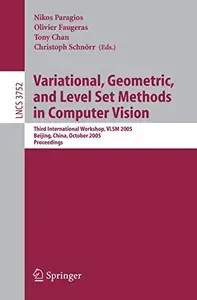- Joined
- Jul 3, 2023
- Messages
- 91,357
- Reaction score
- 1
- Points
- 38

Free Download Variational, Geometric, and Level Set Methods in Computer Vision: Third International Workshop, VLSM 2005, Beijing, China, October 16, 2005. Proceedings By Jing Yuan, Christoph Schnörr (auth.), Nikos Paragios, Olivier Faugeras, Tony Chan, Christoph Schnörr (eds.)
2005 | 372 Pages | ISBN: 3540293485 | PDF | 12 MB
Mathematical methods has been a dominant research path in computational vision leading to a number of areas like ?ltering, segmentation, motion analysis and stereo reconstruction. Within such a branch visual perception tasks can either be addressed through the introduction of application-driven geometric ?ows or through the minimization of problem-driven cost functions where their lowest potential corresponds to image understanding. The 3rd IEEE Workshop on Variational, Geometric and Level Set Methods focused on these novel mathematical techniques and their applications to c- puter vision problems. To this end, from a substantial number of submissions, 30 high-quality papers were selected after a fully blind review process covering a large spectrum of computer-aided visual understanding of the environment. The papers are organized into four thematic areas: (i) Image Filtering and Reconstruction, (ii) Segmentation and Grouping, (iii) Registration and Motion Analysis and (iiii) 3D and Reconstruction. In the ?rst area solutions to image enhancement, inpainting and compression are presented, while more advanced applications like model-free and model-based segmentation are presented in the segmentation area. Registration of curves and images as well as multi-frame segmentation and tracking are part of the motion understanding track, while - troducing computationalprocessesinmanifolds,shapefromshading,calibration and stereo reconstruction are part of the 3D track. We hope that the material presented in the proceedings exceeds your exp- tations and will in?uence your research directions in the future. We would like to acknowledge the support of the Imaging and Visualization Department of Siemens Corporate Research for sponsoring the Best Student Paper Award.
Buy Premium From My Links To Get Resumable Support and Max Speed
Rapidgator
42khx.7z.html
TakeFile
42khx.7z.html
Fileaxa
Loading…
fileaxa.com
42khx.7z.html
Links are Interchangeable - Single Extraction



